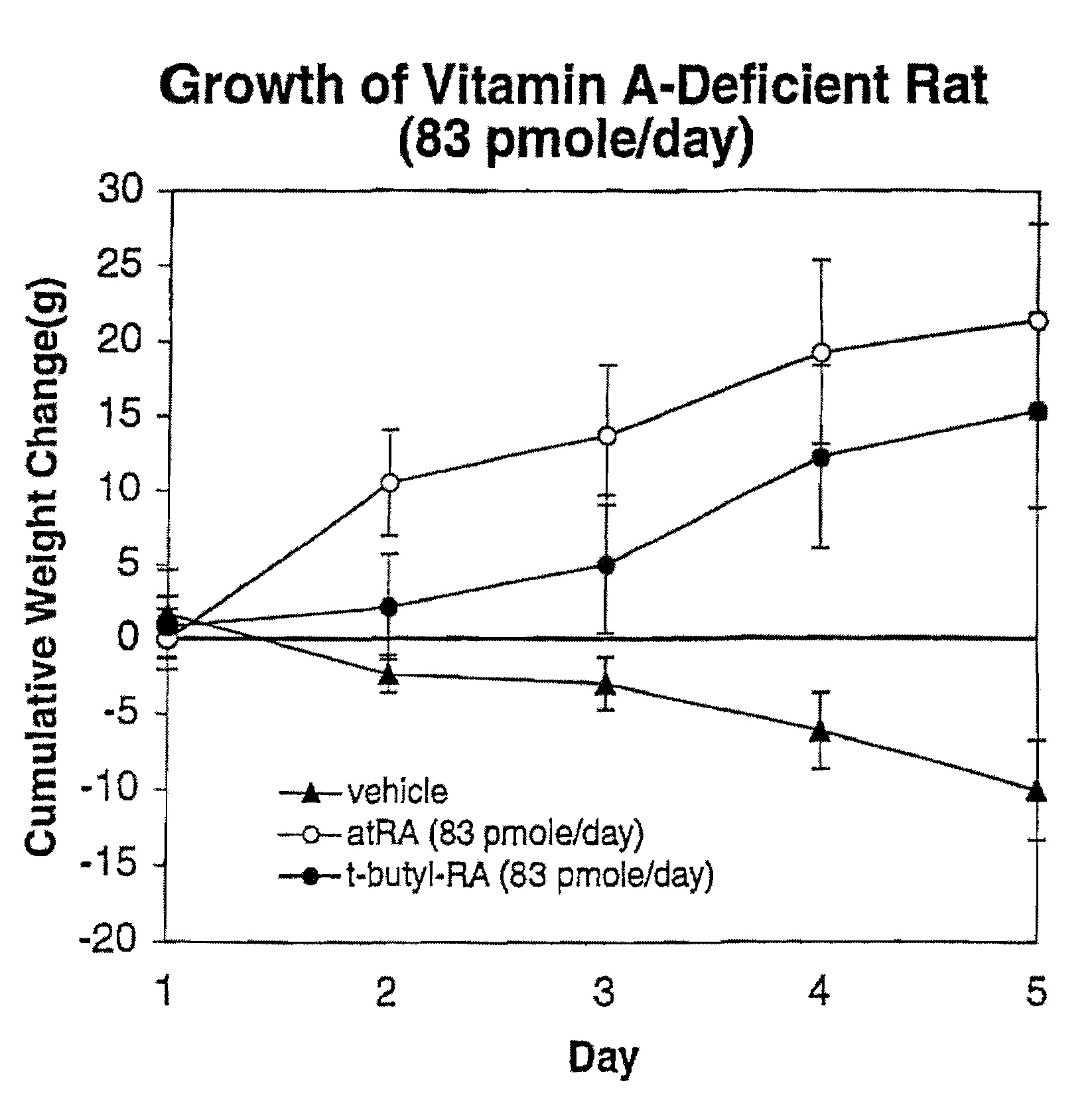Modified Retinoid Compounds and Their Uses
a technology of retinoid compounds and ra isomers, which is applied in the field of retinoids, can solve the problems of reducing the therapeutic window, weight loss, bone loss, and the side effects of ra isomers that are very serious and can be administered orally, so as to reduce the biological action of retinoid compounds, reduce the toxicity, and slow down the biological effect of retinoid compounds
- Summary
- Abstract
- Description
- Claims
- Application Information
AI Technical Summary
Benefits of technology
Problems solved by technology
Method used
Image
Examples
example 1
Scheme 2
[0027]Preparation of all-trans-retinoic acid tert-butyl ester 2: To a solution of all-trans retinoic acid (100 mg, 0.33 mmol) in anhydrous ether was added oxalyl chloride (42.3 mg, 0.333 mmol) at 0° C. and stirred at that temperature for 30 minutes and pyridine (28.7 mg, 0.363 mmol), 2-methyl-2-propanol (26.8 mg, 0.363 mmol) was added and stirred at room temperature in dark after which time the reaction was complete as indicated by the TLC. The reaction mixture was then quenched with water and extracted with ether (3×10 ml), saturated sodium bicarbonate solution (3×5 ml) and again with water (3×5 ml), dried (MgSO4) and evaporated. The thick residue was redissolved in hexane and applied on silica Sep-Pak cartridge (2g). Elution with hexane / ethyl acetate (9.7:0.3) provided the butyl ester of retinoic acid. Final purification was achieved by HPLC (10 mm×25 cm Zorbax-Sil column, 4 mL / min) using hexane / isopropanol (90:10) solvent system. Pure all-trans retinoyl butyrate 2 (98 mg,...
example 2
Scheme 1
[0028]A solution of all-trans retinoic acid (100 mg, 0.33 mmol), N,N-dicyclohexylcarbodiimide (74.2 mg, 0.36 mmol), 2-methyl-2-propanol (26.68 mg, 0.36 mmol) and 4-dimethylaminopyridine (0.12 mg, 0.001 mmol) in anhydrous ether (5 ml) was stirred at room temperature in dark (protected from light) for 24 hours under argon. The N,N-dicyclohexyl urea formed was filtered and the filtrate washed with water (3×10 ml), 5% acetic acid solution (3×5 ml) and again with water (3×5 ml), dried (MgSO4) and evaporated. The solid residue was redissolved in hexane and applied on silica Sep-Pak cartridge (2 g). Elution with hexane (10 ml) gave a small quantity of less polar compounds; further elution with hexane / ethyl acetate (9.7:0.3) provided the butyl ester of retinoic acid. Final purification was achieved by HPLC (10-mm×25 cm Zorbax-Sil column, 4 mL / min) using hexane / isopropanol (90:10) solvent system. Pure all-trans retinoyl butyrate 2 (22 mg, 18.5%) was eluted at R, 13 mL as a thick oil....
example 3
Scheme 3
[0029]A solution of all-trans retinoic acid (100 mg, 0.33 mmol), carbonyldiimidazole (58.3 mg, 0.36 mmol) in anhydrous ether (5 ml) was stirred at room temperature in dark (protected from light) for 2 hours under argon. The imidazole formed was then reacted with 2-methyl-2-propanol (26.68 mg, 0.36 mmol) and stirred for 24 hours in dark at room temperature. The reaction mixture was washed with water (3×10 ml), 5% acetic acid solution (3×5 ml) and again with water (3×5 ml), dried (MgSO4) and evaporated. The solid residue was redissolved in hexane and applied on silica Sep-Pak cartridge (2 g). Elution with hexane (10 ml) gave a small quantity of less polar compounds; further elution with hexane / ethyl acetate (9.7:0.3) provided the butyl ester of retinoic acid. Final purification was achieved by HPLC (10-mm×25 cm Zorbax-Sil column, 4 Ml / min) using hexane / isopropanol (90:10) solvent system. Pure all-trans retinoyl butyrate 2 (18 mg, 15.1%) was eluted at R, 13 Ml as a thick oil. 1...
PUM
| Property | Measurement | Unit |
|---|---|---|
| Mass | aaaaa | aaaaa |
| Mass | aaaaa | aaaaa |
| Mass | aaaaa | aaaaa |
Abstract
Description
Claims
Application Information
 Login to View More
Login to View More - R&D
- Intellectual Property
- Life Sciences
- Materials
- Tech Scout
- Unparalleled Data Quality
- Higher Quality Content
- 60% Fewer Hallucinations
Browse by: Latest US Patents, China's latest patents, Technical Efficacy Thesaurus, Application Domain, Technology Topic, Popular Technical Reports.
© 2025 PatSnap. All rights reserved.Legal|Privacy policy|Modern Slavery Act Transparency Statement|Sitemap|About US| Contact US: help@patsnap.com



